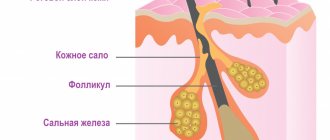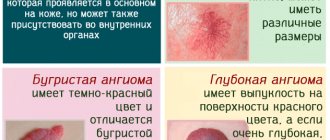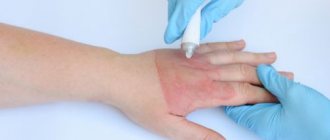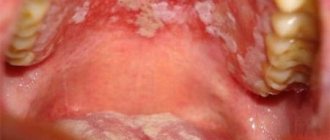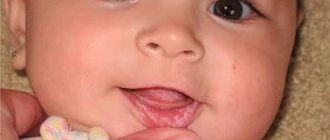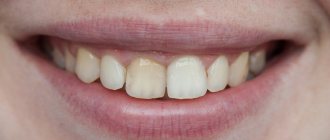From this article you will learn:
- a lump has come out on my lip - what is it?
- what does a cyst look like under the tongue,
- treatment of cysts of the lower lip and under the tongue.
A retention cyst is a convex, rounded formation that occurs as a result of blockage of the duct of one of the small salivary glands located in the thickness of the oral mucosa. Most often, a retention cyst of the lower lip occurs and a little less often - under the tongue. Accidental biting of the lip can lead to the appearance of a cyst, which will cause blockage of the duct of one of the small salivary glands and lead to the accumulation of viscous secretion in it.
The cyst on the lip is soft to the touch and is filled with viscous saliva. If you bite into it, saliva comes out, and the cyst itself collapses and disappears for a while, but after the mucosal defect heals, the cyst is usually filled again with viscous salivary fluid. Therefore, when patients complain that they have a lump on their lip or under their tongue, this is a retention cyst. Its appearance will require you to visit a dental surgeon for a 15-minute surgical operation (with 2-3 stitches).
Retention cyst on the lip: photo
The cyst can be located closer to the surface of the mucous membrane (as if rising above it), or it can be located deeper in the tissues. This is why some patients notice that the bump is inside the lip, while others notice that the bump is on the outside.
Factors contributing to the formation of bubbles:
- Oral diseases: caries, pulpitis, periodontitis, stomatitis;
- Unbalanced diet;
- Allergy to toothpaste or mouthwash;
- Injuries;
- Poor hygiene;
- Hereditary predisposition;
- Hormonal imbalance;
- Immunity impairment;
- Alcohol and nicotine addiction.
Watery blisters on the mucous membrane in some cases can indicate the occurrence of serious diseases. Such manifestations occur with tuberculosis, syphilis or diabetes. Therefore, if such a pathology occurs, it is recommended to immediately make an appointment with a doctor and undergo the necessary examination. The first sign is the sensation of a strange object in the mouth that is in the way.
Blisters on the mucous membrane of the lips in children
Dropsy appears on the lips of children for the following reasons:
- In newborns, blisters are often caused by excessive sucking during feeding (“food blister”). Such formation disappears on its own without any consequences.
- Bubbles with purulent contents indicate aphthous stomatitis.
- A large number of small white blisters on a child’s lips indicates the presence of a serious illness: chickenpox, measles or rubella.
If a pimple appears on the mucous membrane of your baby’s mouth, you don’t have to wait for it to go away on your own. It is better to contact your pediatrician immediately.
Symptoms
- Painful sensations when eating occur if a bubble has formed in the gum area or on the tongue;
- Pain when talking or smiling appears when a formation occurs on the inner surface of the lip;
- Pain in the throat area occurs if the bubble is located at the root of the tongue.
Transparent and bloody blisters can be not only inflammatory in nature. If the formation does not cause pain and is not accompanied by swelling, then you should consult a dermatologist. It is not recommended to treat yourself in such a situation, as it can be dangerous to health.
Treatment Options
A small blister on the lip inside the mouth may disappear on its own , usually 20–60 days after the development of the tumor. But with weak immunity and the presence of concomitant diseases, the pathology can become chronic. In this case, even the surgical operation performed does not guarantee the complete disappearance of the blister. It will be deleted, but after some time it will appear again. Therefore, before radical intervention, it is better to try more gentle methods of therapy; for many patients they will be much more effective.
Medications must be prescribed by a doctor, since there is no universal cure for blisters on the oral mucosa. Each pathology has its own treatment protocol. Self-medication can lead to the pathology becoming chronic: blisters will pop up almost every day.
Drug names
When patients develop watery herpetic blisters, they are prescribed antiviral drugs:
- Virolex.
- Acyclovir.
- Zovirax.
- Medovir.
If water bubbles appear on the lips of a pregnant woman, the doctor will prescribe gentle therapy: treating the painful area with Oxolinic, Alpizarin or Tromontadine ointment. In consultation with your doctor, it is possible to use Acyclovir. Herpetic infection is not particularly dangerous for the fetus if treated correctly.
In parallel with antiviral drugs, it is necessary to use drugs to improve the condition of the immune system: Imudon, Aflubin. Sometimes patients are prescribed vitamin injections. To activate local immunity, you can smear the inside and outside of your lips with aqueous vitamin solutions.
If a person has caries, it must be cured, and the oral cavity itself must be sanitized. After this, you need to periodically treat the mucous membranes inside and outside the mouth with antiseptic drugs:
- Furacilin.
- Chlorhexidine.
- Miramistin.
To prevent the development of complications and anaphylactic shock, the doctor may prescribe the patient weak antihistamines, for example, Diazolin. If blisters in the mouth appear due to allergies, the patient will be prescribed stronger antihistamines: Suprastin, Zodak, Erius.
The transparent bubble (ball) on the inside of the lip does not hurt so much that painkillers are required. But sometimes medications based on lidocaine may be prescribed. They are usually indicated for patients with a low pain threshold and high sensitivity.
Antibacterial therapy for the occurrence of vesicular neoplasms on the lower or upper lip is needed only when a secondary infection occurs. Most often, blisters and pimples on the oral mucosa can be cured without antibiotics. There is only one exception - if a pimple appears on a patient with AIDS or tuberculosis, antibacterial agents will definitely be needed.
Surgical removal of the resulting blister
If a blister that pops up on the lip inside the mouth does not go away within a month, you will have to remove it with a scalpel or laser. You cannot open the bladder yourself; illiterate actions can lead to infection of the wound and a general deterioration of the condition.
In the clinic, tumors in the mouth are removed under local anesthesia; the operation is quick. Sometimes doctors decide not to remove the bubble, but to form a new channel for the removal of saliva.
Surgical intervention is indicated for mucocele and if the cause of the appearance of blisters on the lips is trauma, but opening herpes blisters is useless: the balls will only thicken and become more painful. Other types of dropsy are also best treated with medications.
What to do at home
Most often, the following folk remedies are used to combat white blisters on the inside of the lip:
- lotions from calendula tincture;
- applications based on sea buckthorn oil;
- oral baths based on bee products;
- ointments based on butter and propolis.
In addition, you can rinse your mouth with chamomile decoction or soda solution 4-5 times a day to prevent infection of healthy areas of the mucous membrane inside and outside the oral cavity. But using exclusively traditional medicine to treat tumors in the mouth is dangerous and simply unacceptable; they must be combined with medications.
A clear water bead can form on the inside of the lower lip for a variety of reasons. Whatever blisters pop up in your mouth, you need to go to a dermatologist or dentist, and then follow their recommendations. Any pimple that pops up in the mouth requires attention, diagnosis and timely treatment.
Treatment methods depending on the cause:
- If the formation occurs due to a viral infection, then treatment will be based on the use of antiviral drugs;
- If the cause is injury, then it is necessary to eliminate the consequences and rinse the mouth with antiseptics;
- If an allergic reaction provokes an illness, then you should find out what the irritant is and not use it anymore. The doctor will also prescribe antihistamines;
- If a large bloody bubble has formed, then surgery is performed. After this, the doctor prescribes medications for rapid tissue regeneration and restoration.
Auxiliary symptoms
A blister that has appeared on the lip on the side of the mouth cannot but bother the owner. If the cause of the tumor is an injury, the patient will feel a gradually subsiding acute pain. The mucous membrane will begin to swell and turn slightly red. Slight hyperthermia (heating) of the tissue at the site of injury, burning and itching are possible. Some patients experience fever accompanied by chills.
Regional lymph nodes enlarge and may become too sensitive to touch. Such a symptom may appear immediately after a pimple appears on the oral mucosa.
The appearance of watery blisters on the lips is often accompanied by general weakness and lethargy. A person quickly gets tired and begins to refuse food. The blister can burst due to injury from teeth or food, as a result of which all the liquid pours out, and the blister itself begins to gain volume again.
Reasons for appearance
Blisters on the lips can appear for a variety of reasons. If a person accidentally damages the mucous membrane with his teeth, this leads to the appearance of a neoplasm.
When tissue is damaged, inflammation of the cellular structure occurs, against which a blister appears. Pathology can also appear in patients with a variety of dental diseases.
Poor diet is often the cause.
For damage that is mechanical in nature, a blister may appear. Improper oral care leads to the development of pathology.
It can also occur against the background of an allergic reaction or predisposition. Improper functioning of the hormonal system is the cause of pathology. Blisters can also occur due to a variety of diseases:
- Candidiasis;
- Herpes;
- Shingles;
- Pemphigus;
- Glossalgia.
Blisters on the lips can be caused by the person themselves or occur against the background of a variety of diseases. In the second case, it is imperative to seek help from a doctor who will prescribe rational treatment.
Symptoms
If the pathological condition was provoked by the patient himself, then, as a rule, it is not accompanied by additional symptoms. When the disease appears, the patient begins to complain of pain.
Quite often the blister causes a burning sensation.
Most patients complain of itching. Some patients experience fever, which may be followed by chills. Lymph nodes may enlarge when a pathological condition appears.
These diseases may be accompanied by general malaise. A person gets tired quickly even when doing usual things. Due to the discomfort caused by the blister, patients most often lose their appetite.
If at least a few of the above symptoms appear, a person needs to see a doctor. Only a specialist, based on the research conducted, can correctly diagnose and prescribe rational treatment.
Diagnosis: which doctor to contact
You should consult a doctor in case of complications (for example, headaches), as well as in cases where the rash becomes more and more numerous and does not go away for a long time. For herpes, contact the following specialists:
- gynecologist (for women);
- urologist (for men);
- therapist (if the rash does not appear in intimate areas);
- pediatrician (for treating children).
The doctor examines the patient, asks questions, analyzes complaints. If necessary, several laboratory tests are carried out to study:
- blood;
- sperm;
- urine;
- vaginal discharge;
- urethral discharge;
- biological material from ulcers or other skin lesions.
Along with the cause of the rash, it is equally important to determine the type of virus. To do this, a common PCR analysis is performed, which stands for polymerase chain reaction.
Blood blister on the lower, upper, or inner lips
Blood spots that form in the inner upper or lower lips are usually caused by trauma. Often these injuries are caused by friction or accidental biting of the teeth. However, this does not exclude the possibility of other causes such as viral or infectious symptoms.
On the other hand, blood blisters that form on the outer upper or lower lips are usually caused by infections and viral diseases. However, in rare cases, they can be caused by injuries.
Bloody pimple inside the lip
Why does a lump form on the lip?
As we said above, a retention cyst forms inside one of the small salivary glands, which are massively scattered throughout the mucous membrane of the entire oral cavity (24stoma.ru). Each such salivary gland has a thin duct that opens on the surface of the mucous membrane and allows the secretion of the salivary gland to enter the oral cavity. When this duct is blocked, the secretion of the salivary gland accumulates in its lumen, stretching the walls of the gland.
The cause of duct blockage is usually mechanical trauma to the mucous membrane. This is why patients note that as soon as they bit their lip, a lump formed. The secretion in the salivary gland is constantly being formed, and therefore the lump on the lip will constantly increase in size - until either spontaneous opening occurs, or you accidentally or deliberately bite through it. If the integrity of the cyst is violated, then you can see how a clear viscous liquid leaks out of it onto the surface of the mucous membrane.
After emptying, the cyst collapses, and for some time you do not notice it. Remember that you cannot deliberately bite or puncture such a cyst (for example, with a needle). The fact is that even if the secretion of the gland comes out, the cyst shell will still remain inside the tissue. This will result in the same cyst forming over and over again.
Blood blisters on the tongue, sides, and tip of the tongue
Bloody pimples and blisters are also very common on the tongue. Typically, a huge blister of blood appears on the tongue or close to the middle or tip of the tongue. Bloody blisters can also form on different sides of the tongue. It is also possible to have more than one blood blister on the tongue if there are many of them. , they are usually smaller in size.
Bloody bubble on tongue
The most common causes of small to medium-sized blood blisters on the tongue are injuries, most often due to tongue biting. However, the infections and diseases and conditions discussed can cause blood blisters on the tongue. They are usually very painful and cause a lot of discomfort .
Depending on the size and severity of the blood bubble, you may have difficulty and pain in speaking, or may not be able to speak at all. Chewing and swallowing food can also become very painful processes.
Causes of herpes
Herpes simplex virus type 1 (HSV-1) can be transmitted through household contact. Airborne transmission is also possible.
The airborne route is the main route of infection with the varicella zoster virus.
Genital herpes and cytomegalovirus are transmitted sexually.
You can also become infected with herpes through blood or saliva. The virus can be transmitted through saliva through kissing. Small children who put things in their mouths every now and then are also very vulnerable. If at least one child in a children's group is infected, a rapid spread of the infection can be expected.
Blood blisters on or inside the cheek
The main cause of blood blisters on the inside of the cheeks is friction against sharp or ingrown teeth when you eat. Gentle rubbing usually results in the formation of a painless blood blister on the inside of the cheeks.
In case your teeth are very sharp, you can fix them through dental surgery by cutting off the sharp ends. Otherwise, you will often bite or rub them on your inner cheeks and cause injuries, which may lead to blood blisters from time to time. In some cases, you You may bite your cheek when speaking or chewing food.
Super plant Kalanchoe for acne!

